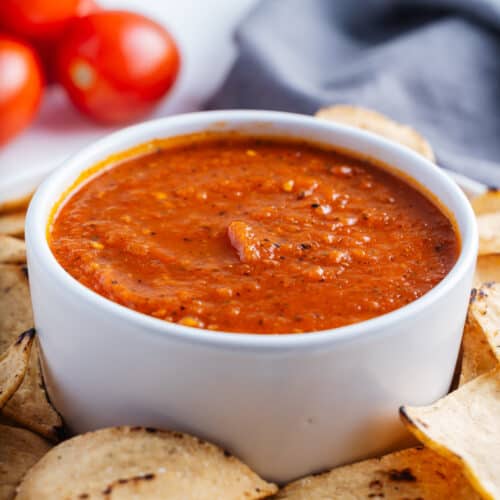Salsa Taquera
This 5-ingredient salsa taquera recipe is ready in 15 minutes and packed with bold, spicy, and savory flavors. Showcasing arbol chiles, tomatoes, and fresh garlic, it pairs perfectly with just about any Mexican dish. Serve it with tacos, burritos, tortas, and more!

With a beautiful orange hue, it’s hard to miss salsa taquera at pretty much any taco stand or taquería around Mexico. Along with salsa roja and salsa verde, you can always find a jar of it in my fridge!
Why I love this recipe
Using basic, affordable ingredients, salsa taquera is the perfect way to add a kick to your favorite Mexican dishes. With a total preparation time of 15 minutes, it’s great when you need a quick yet flavorful condiment.
It’s crafted with a blend of arbol chiles, savory aromatics, and fresh lime juice, giving you an authentically spicy, tangy, and slightly smoky flavor.
All you have to do is cook the components, then blend the mixture into a smooth, vibrant orange sauce. It’s great for anyone who loves a bit of spice and is suitable for all dietary preferences!
Ingredient notes
All of the ingredients in this recipe are easy to find and inexpensive. Find a full breakdown and suitable substitutes below!

Arbol chiles
Also known as chiles de árbol, these small Mexican peppers have a bright red color and slightly nutty flavor with a hint of smoke. They are quite spicy, ranging from 15,000-30,000 Scoville Heat Units compared to 2,500-8,000 for jalapenos.
Substitute: With the exact same heat level, piquin chiles are a good substitute for arbol chiles. Cayenne peppers can be used for a slightly higher spice level.
Roma tomatoes
Roma tomatoes add a juicy, zesty, and slightly sweet flavor that balances the heat of the chiles. Since these tomatoes have low water content and their flavor deepens once cooked, they make the perfect salsa component.
Substitute: Canned diced tomatoes can be used, but the freshness and texture will be slightly different.
Lime juice
Lime juice brings a bright acidity, cutting through the savory heat of the other ingredients. I find the flavor of lemon to be too sweet and overpowering for this recipe.
For a complete ingredient list and step-by-step guide, scroll down to the recipe card.
How to make
Learn how easy it is to make salsa taquera with my step-by-step instructions. Look for the tips in green throughout this section for the best results! Also, you can watch my video tutorial down below!
Preparation
Cut the stems off the chiles using kitchen shears, then lightly shake out some of the seeds. You don’t need to get every seed out, but it helps reduce the spice. Chop the white onion, garlic, and Roma tomatoes. This doesn’t have to be perfect, as they will be blended later.

Cooking
Step 1
Heat a skillet over medium and toast the chiles for 2-3 minutes. Stir them frequently until they become fragrant, which enhances their flavor and brings out a smoky aroma.
Be careful not to burn the chiles. If they start to smoke or smell acrid, they’ve gone too far and will make your salsa bitter. It’s better to under-toast them if you’re unsure.

Step 2
Bring a pot of water to a boil, then add the chiles and turn the heat off. Let them sit for about 15 minutes until they soften.
It’s best to avoid boiling dried chiles to rehydrate them since their flavor can transfer too much to the water.

Step 3
Heat the olive oil in a skillet over medium. Add the chopped onions and cook until they’re translucent, then add the garlic and finally the tomatoes. Continue cooking until the tomatoes are tender and slightly browned.
Cooking the onions, garlic, and tomatoes before blending brings out their natural sweetness, which balances the heat of the chiles beautifully.

Step 4
Blend the onion mixture with the drained chiles, lime juice, and salt until smooth. If necessary, add some reserved chile water to help move the blender. You’re looking for a smooth, pourable salsa.
Before using the chile water, taste it to see if it’s bitter. If it is bitter, I recommend using filtered water instead.

Expert tip
The most important component of making a vibrant-tasting salsa taquera is the preparation of the chiles. Toasting them helps release their deep, smoky flavor, but you don’t want to introduce bitterness to the sauce by burning them.
Keep a close eye on the arbol chiles as they toast, and remove them from the skillet when they start smelling fragrant.
You can also customize the heat of this salsa by removing more or less chile seeds. If you prefer a milder spice, remove all of the seeds. If you like it hot, leave them all in!
Serving suggestions
Salsa taquera makes the perfect complement to vegan Mexican tacos like vegan birria tacos, vegan tacos al pastor, and jackfruit carnitas tacos.
I love to serve it with vegan quesadillas, vegan empanadas, my morning vegan breakfast burritos, or simply some totopos. Its bold, smoky flavor also makes it a great addition to pan-fried tofu!
Cooking tips
Proper ventilation when toasting: Make sure your kitchen is well-ventilated, as the toasting process can release intense aromas that might be overwhelming.
Fresh arbol chiles: Use pliable, fragrant arbol chiles for the best flavor. If you need help determining how to choose arbol chiles, check out our dedicated arbol chile post.
Use a high-speed blender: I recommend using a high-powered blender, like a Vitamix or Blendtec, for the smoothest consistency.
Strain for smoothness: If you don’t have a high-speed blender or prefer it extra smooth, strain the salsa after blending to remove any chunks.

Frequently asked questions
Toasting dried chiles releases their oils and enhances their flavor, but you can skip this step for a milder-tasting salsa.
Add more tomatoes or a pinch of sugar to balance the heat.
They should be fragrant but not burnt. Watch for a slight color change and a toasty aroma.
Canning is possible for salsa, but this recipe is not safe for canning.
Storing & reheating
Salsa taquera is great to make ahead of time and keep on hand for easy access throughout the week. Just let it cool before storing it.
Fridge
Transfer the salsa to an airtight container, and it will stay fresh for up to a week in the refrigerator. Glass mason jars are ideal as they don’t absorb flavors as much as plastic.
Freezer
You can freeze salsa taquera for up to 6 months. Store it in a freezer-safe container or bag, and thaw it in the refrigerator overnight. If the texture has changed too much, give it a blitz in the blender before serving it again.
Watch how to make it
More salsa recipes
Hungry for more?
If you enjoyed this recipe, please consider leaving a star rating and a comment down below! Your feedback not only helps others discover our blog but also gives us valuable insights from your experience.
Don’t forget to subscribe to our newsletter for the latest recipes, and check out our shop for our top kitchen recommendations. Thank you for supporting BBV!
Recipe

Easy Salsa Taquera (5 Ingredients)
Equipment
- Skillet
- Saucepan
- Blender
Ingredients
- 30 arbol chiles
- 2 tablespoons olive oil
- ½ medium white onion (roughly chopped)
- 2 cloves garlic (roughly chopped)
- 2 medium Roma tomatoes (roughly chopped)
- 2 tablespoons lime juice
- 1 teaspoon salt
Instructions
- Stem and lightly shake out the seeds of the chiles (don't worry about getting all the seeds out). Heat a skillet over medium and toast the chiles for 2-3 minutes, stirring frequently, until fragrant.
- Bring a medium saucepan of water to a gentle boil, then add the chiles and turn the heat off. Let them soak until they are soft. Reserve a few tablespoons of cooking water and drain the rest.
- In the meantime, heat the olive oil in a skillet over medium. Add in the onions and cook for 3-4 minutes until translucent. Stir in the garlic and cook for another 1-2 minutes. Lastly, add in the tomatoes and continue cooking until soft and lightly browned, about 5 minutes.
- Transfer the onion mixture to a blender along with the drained chiles, lime juice, and salt. Blend on high until smooth, stopping to scrape down the sides a few times. If your salsa is not blending, add in some of the reserved chile water, 1 teaspoon at a time.
- If you don't have a high-speed blender, strain the mixture into a bowl or container for storage. Serve it with tacos, burritos, etc. Happy Eating!
Notes
Nutrition
Note: I’ve updated this post to include new information and helpful tips about the recipe.
Mitch Chapman is a food writer, photographer, and one of the founders of Broke Bank Vegan. With a background in healthcare and the restaurant industry, he has a passion for sharing healthy yet flavorful plant-based food.






